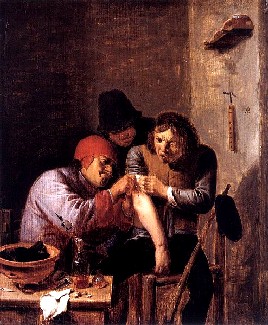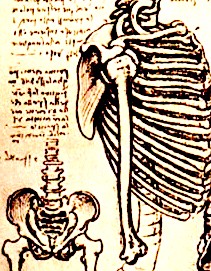
Amputation Page Menu: 1 2 3 4 5 6 7 8 9 10 11 12 Next>>
Amputation During the Golden Age of Piracy, Page 9
Post-Operative Considerations
Once the bleeding was stopped in the amputated limb, the surgical authors discussed post-operative considerations that they felt affected the healing process.
Post-Operative Consideration: Bleeding the Patient
Believe it or not, despite the fact that there was great concern and discussion about ways to stop bleeding veins and arteries, some surgical authors comment on whether or not to bleed patients once the limb was removed. Bleeding was something of a cure-all at this time as can be seen in the Bloodletting Procedure pages. So it may have occurred to young surgeons that it would be necessary following such a major operation. However, Pierre Dionis dispels the notion in his period textbook.

Feeling by Adrien Brouer (1635)
"'Tis needless to prescribe the allowing the Evacuation of a certain Quantity of blood to disgorge the Part; for notwithstanding the utmost Care of the Operator to stop the Flux, there will issue out always too much of that Liquor [the blood]: All that which was in the Leg is lost, and almost all the Veins of the Thigh empty themselves, as well during the Operation, as after 'tis finish'd, without its being in our power to hinder it; wherefore that quantity is sufficient, without our voluntarily suffering any more to run out, which can be only the arterial Blood, the lots of which would rather enfeeble than relieve the Patient: Wherefore we are, as soon as possibly we can, to stop it by Ligature, and preserve the strength and vigour of the Patient."1
While it seems pretty obvious, John Woodall suggests differently if the amputation was necessitated by a gangrened limb. "Note also it is convenient if the occasion of dismembering grow by reason of a Gangrene... [if] the spirits not wasted before with long sicknes, to let go some reasonable quantity of bloud in dismembering, because it is supposed to be vemous".2 However, he also explains that, "in a spent weak body, who hath had a long pining disease, preserve his bloud and spirits, as carefull as if they were thine owne".3 Very sensible, right? He keeps going, however, apparently wanting to cover all bases by "remembring this one rule, which all the London Hospitall Surgeons holde, there is more hope in a weake spent body, then in a full body".4 It's kind of difficult to know what to make of such a divergent commentary. The junior surgeon might be as confused as you are right now after reading all that!
1 Pierre Dionis, A course of chirurgical operations: demonstrated in the royal garden at Paris. 2nd ed., p. 413; 2 John Woodall, the surgions mate, p. 175; 3 Ibid.; 4 Ibid.
Post-Operative Consideration: The Effects of Air on Exposed Bone
At this time, "bad" air was believed to cause all sorts of maladies, probably stemming from a lack of understanding of what caused diseases to spread. Nearly every surgeon and sailor's journal has some comment in it suggesting that bad air was to be avoided as it led to illnesses. The same was also felt to be true by some surgeon's for the effect of air upon wounds. When addressing gunshot wounds, William Clowes talks passionately about "the corruption of the air, especially in hot and moist regions, for there the air is most apt to increase putrefaction, insomuch that Butchers do refuse to kill flesh but for one day during the time. Moreover, such accidents do happen by reason of rotten and stinking mists rising out of marsh grounds, being near sea coasts, and also from dead carcases, corrupt laystalls and ditches, and where are multitude of people; especially in camps and great armies of men, many loathsome and stinking venomous vapours are engendered, all which corrupt airs being received into their bodies that are wounded with gun shot, and so meeting with bodies that be of an ill

Leonardo Da Vinci studies of bones.
OK, this is only tangentially related
to the text, but isn't it a cool drawing?
disposition called Cacochimia (a bad constitution, abounding in evil humours), oftentimes do so breed venomous and poisoned wounds."1
There was some concern about how much time the newly incised wound, and particularly the uncovered bone, would be exposed to this potentially dangerous element. Ambroise Paré advised that the surgeon "cover them [the bones] as close as you can, that so the ayre may the lesse come at them, and that so the wound may bee the more speedily agglutinated [stuck together]."2 John Atkins suggests using a cloth to cover the bone after amputation so that it is "guarded from the Intrusion of Air, [so] that Exfoliation is often prevented, or (which is the same) becomes insensible".3 Where this wasn't possible, "the Bones become necessarily prominent, and exposed) to the corrupting Quality of Air, and Fluctuation of Matter; bothe which concur to render such Prevention difficult, if not impossible; nay, perhaps, it would rather expedite the Cure (in these Cases) if we helped (from the Beginning) to foul it with the same greasy Applications we use to the Wound."4
Curiously, the period surgeons just missed an actual benefit of limiting a wound's long-term exposure to the air. "Exposing a wound to the air so it can breathe is a terrible mistake, experts say, because it creates a dry environment that promotes cell death. A handful of studies have found that when wounds are kept moist and covered, blood vessels regenerate faster and the number of cells that cause inflammation drop more rapidly than they do in wounds allowed to air out."5 So maybe there was something to all that concern after all.
1 William Clowes, Selected Writings of William Clowes, p. 138; 2 Ambroise Paré, The Apologie and Treatise of Ambroise Paré, p. 150-1; 3 John Atkins, The Navy Surgeon, p. 128; 4 Ibid.; 5 "The Claim: Wounds Heal Better When Exposed to Air" by Anahad O'Conner, 8/1/2006, New York Times On-line gathered 4/8/12
Post-Operative Procedures
Once all the cutting was complete, some immediate post-operative procedures took place. The biggest concern was suturing the skin to cover the wound so that healing could begin. Following that, bandaging the limb came to the fore. The process Bandaging was rather complex as we'll see.
Post-Operative Procedure: Suturing the Amputated Limb
Suturing or sewing the wound closed was the first order of business. Ambroise Paré instructed the surgeon to "draw together the lippes of the wound with foure stitches made acrosse, having taken good hold of the flesh; for thus you shall draw over the bones that part of the skinne and cut muscles drawne upwards before the amputation, and cover them as close as you can... you must not so understand it, as that you must endeavour, to draw them so close as to touch each other, for that is impossible; for the stitches would sooner breake out, and so the part would lye bare. Wherefore it will be sufficient to draw them indifferent close together, that so you may suffer the skinne and flesh thereunder to enjoy its former liberty which it possest before the drawing up, and so... by natures assistance, the wound may be the more easily agglutinated [literally "glued together." by the formation of new skin]."1 As you can see from Paré's procedure, there were basically two steps in this procedure: bringing the two sides of the wound close together and then stitching them so that they remain in that position and heal.

Suturing needle for amputation, taken from Johannes Scultetus'
"The chirurgeon's storehouse"
When pulling the skin down, John Moyle explains in his Memoirs that in one case he "caused the Griper [gripper - person holding muscle and skin up above the point of incision during the actual amputation] to thrust down the Muscles with his Hands, as far over the end of the Bone as possible"2, making one of his assistants hold the skin for the stitch. This may sound as if it would hurt, but Richard Wise man explains that if the "musculous Flesh and Skin are well pulled up in time of Amputation, and brought over by a moderate Extension as far as they will easily admit, you will find it not painful."3
When stitching the skin, John Woodall explains that this is done taking two "strong square needle and threds mentioned, &... stitch the skin through on the outside and just over the other side, and with the other needle doe likewise as it were crosse over the member the other way, and draw the said threds so close as you thinke convenient".4 In his Memoirs, John Moyle provides some more detail along with a different way to tie the thread off, saying "I past one of my Needles, (entering it on the outside) through the Cutis and Musculous Flesh, about half an Inch from the Edge, and then through the contrary side from within outward, drawing the doubled Thread about half way through, the same I did with the other Needle right cross this, then cutting off the Needles, I drew the Threads as tort as convenient, and fastened them with Buttons of Tow [inexpensive linen cloth formed into button-like shapes] at each end which holds better then to tye them Cross."5 Wiseman suggested that "[y]ou ought to pierce the Skin with a Needle and strong brown Thred ceared [waxed] about half an inch from the edges of the Lips."6
Both John Woodall7 and Richard Wiseman indicate suturing was a contentious point among the surgical writers. According to Wiseman, "They that object against [stitching] say, it causes Pain and Inflammation. So doth Bandage also, if it be made too straight [tight]."8 Wiseman explains the problem with wounds dressed with bandages and no stitch. "[W]ithout the cross Stitch [the stumps] have [at] the next dressing been broad Stumps, some of them with Lips turned outward by the Bandage; in the least of them the whole Stump hath been bare: Whereas in those in which I have made the cross Stitch, the Lips have been found close to the Bone at the next dressing, covering the great Vessels, and a third part of half of the Stump hath been well digested, and by the second dressing hath been near agglutinated so far it lay under that Skin, and without Inflammation happily cured."9 He opposes bandaging without stitching saying it results in, "a long Cure, and commonly the death of the Patient."10 Matthias Gottfried Purmann suggests another method, which keeps the skin "together with good sticking Plaisters, or four good Stitches."11 No one comments on the efficacy of using sticking plasters, although one might think they would tend to rip open newly forming skin if not carefully removed.
1 Ambroise Paré, The Apologie and Treatise of Ambroise Paré, p. 150-1; 2 John Moyle, Memoirs: Of many Extraordinary Cures, p. 121; 3 Richard Wiseman, Of Wounds, Severall Chirurgicall Treatises, p. 453; 4 John Woodall, the surgions mate, p. 174; 5 Moyle, Memoirs, p. 121; 6 Wiseman, p. 453; 7 Woodall, p. 174; 8 Wiseman,p. 453; 9 Ibid; 10 Ibid; 11 Matthias Gottfried Purmann, Churgia Curiosa, p. 210

